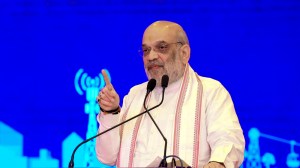Into the heart of the Himalayas
Forty-six is not normally an age at which to set out on a solo 1,500 km trans-Himalayan trekking expedition. But for Pramod Govande, it w...

Forty-six is not normally an age at which to set out on a solo 1,500 km trans-Himalayan trekking expedition. But for Pramod Govande, it was a once-in-a-lifetime opportunity and he was determined not to let age stand in the way.
Actually, the expedition, which included many tough treks, did not start out as a solo affair, as senior mountaineer Girish Kulkarni was to join Govande throughout – from Leh to Darjeeling. But Kulkarni, due to some personal problems, could accompany him only up to Zanskar, the first stop.
“I was undergoing the basic mountaineer’s course at the Western Himalayan Mountaineering Institute in Manali in 1981. The sherpas training me had accompanied Sir Edmund Hillary on a trans-Himalayan trek the previous year.” Their enthusiastic talk got him thinking about undertaking an expedition himself, a plan that took concrete shape in 1995.
“A trek like this needs a lot of planning. I had already started systematic exercises of load-carrying and jogging every day to build up stamina,” he says. For Govande, a mountaineer of 17 years standing, his only apprehension was whether he would be able to undertake such a long trek at his age. “I attempted to scale Mount Rudugaira a little before this expedition and regained my confidence when I was successful,” he says. Unable to secure a sponsor for his expedition, Govande raised a loan while some friends chipped in to cover the Rs. 1.25 lakh for the expedition. The expedition’s route was chalked out within the altitude range of 8,000 and 17,000 ft.
D-Day arrived on August 12, 1997, when Govande, along with Kulkarni, started from Lamayuru, 124 km away from Leh, on the way to Srinagar. “The picturesque Zanskar valley, surrounded by the Great Himalayan range, was the toughest, and most scenic, part of the expedition. This region, called the Area of Painted Rocks due to multi-coloured lichen, has a stark beauty and the spectacular honey-comb-shaped Phuktal monastery, cut into the rock under a gigantic grotto, is also here,” says Govande. On his own by now, Govande braced himself for the 22-day trek to Darcha, which he found to be most arduous. “I hired local porters to carry my luggage with me from point to point and would pick up food locally. We would camp in the open or in caves along the way. Sometimes we encountered wild animals but they usually kept away,” he remembers.
Most of the trekking was done between 6.30 a.m. and 1 p.m., after which Govande would set up camp. A week after stopping at Manali, Govande was at Beas Kund, the doorway to the Garhwal Himalayas, moving slowly to acclimatise himself. “The Garhwal is the most charming locale in the Indian Himalayas – – one treks through thick forests and beautiful mountainous scenery. The sparkling lake at Dodital, famous for its Himalyan trout, the waterfall with a sheer drop of more than 2,000 m from the snows of Banderpooch in the valley near Yamunotri and the hot water spring at Suryakund were sights to treasure,” he says.
And while he had to contend with loneliness, his practice of reiki and meditation helped him get through it. From Uttarkashi, Govande started the tough three-day trek over mountainous terrain to Kedartal, and then onwards to the Gaumukh glacier, the source of the holy Ganges. “This was a relatively easy trek, leading to Nandanwan and Tapowan, both considered ideal camping spots.”
Eight days and 28 km later, Govande was the Malla village, from where the route leads to the Kedarnath and Badrinath temples. “As the crow flies, Badrinath is only 42 km away but via the Panchkedar, it takes almost eight days. The trek passes through wild orchards and involves trekking over high ridges (sometimes 4,000 m),” he says.
Govande remembers the pyramid-shaped snowy peak of Neelkanth, popularly known as Garhwal Queen, towering over Badrinath at a height of 6597 m, as the most dramatic sight in this region.
The gruelling and hazardous 25 km trek from Badrinath leads to the base of the Satopanth peak (at an elevation of 4,402 m) and innerline permit is necessary to gain access to this region. By Govande’s next stop, in the Kumaon region of Pithoragarh, bordering on Nepal, almost 1,000 km of the trek had been covered.
“The Annapurna base camp trek affords a fine opportunity to surround oneself with Himalayan peaks in a short span of time without having to contend with extreme altitudes and flight problems. The trek begins from Pokhara, known for its large Phewa lake, and the spectacular panorama of the Annapurna, Macchapucchare and Manaslu peaks dominates the skyline,” says Govande.
The mountaineer had now entered the final phase – with the Everest base camp as its highlight. “Unfortunately, the flight from Kathmandu to Lulka, from where I could proceed to the base camp, was cancelled due to bad weather. To keep to the schedule, I could wait no longer.” Disappointed but determined, Govande carried on, hitting the last stop of Darjeeling on November 17, on what he claims to be the longest solo high altitude trek, covering 1,500 km in 110 days. “I feel a sense of achievement, of having fulfiled the task I set out to do,” smiles Govande. And what a trip it’s been!
Photos





- 01
- 02
- 03
- 04
- 05


























